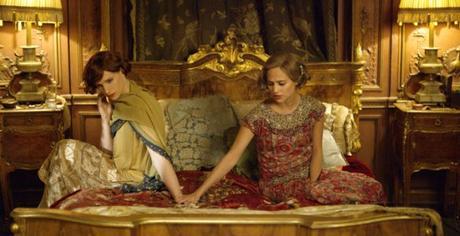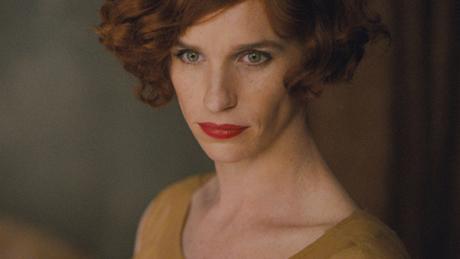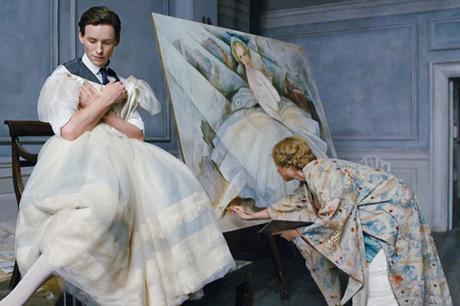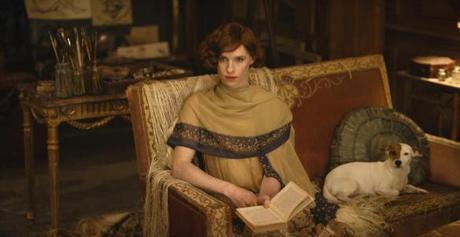Director Tom Hooper created a thoroughly English bio-drama of groundbreaking transgender figure Lili Elbe and the artist wife who stood by her husband Einar Wegener throughout his long and difficult transition to live as a woman.
Based on David Ebershoff’s novel of the same title, “ THE DANISH GIRL” is a fictionalized but sensitive, high-profile portrait of transgender pioneer Lili Elbe. Lili Elbe, nee Einar Wegener, who was one of the first to make a “sex change” via surgery. Tom Hooper won an Oscar for “The King’s Speech,” and this year “The Danish Girl” allows last year’s Oscar winner for best actor, Eddie Redmayne, to transform himself yet again. Indeed, transformation and performance are themes of the movie. Eddie Redmayne, in the lead role, plays a difficult transformational role.
When “The Danish Girl” first introduces Eddie Redmayne’s character, he is dapperly costumed as a Danish gentleman, making eyes across a gallery opening at his wife, Gerda (played by Alicia Vikander). We meet the husband and wife couple Gerda and Einar Wegener, both painters, living amid the soft colors and sea air of Copenhagen in 1926. Gerda is a portraitist, while Einar’s landscapes — drawn from his childhood memories of the fjords and marshlands of Vejle, a town on the Jutland peninsula — have brought him a measure of fame.

Through a process that is by turns wrenching and exciting, Einar discovers that the man the world has always taken him to be is not the person he truly is. What begins as an experiment and a bit of a game — dressing as a woman for the Copenhagen artist’s ball, wearing one of Gerda’s camisoles under his clothes — becomes an existential transformation.
Outsiders always want to know what makes LGBT people “that way,” seeking psychological answers to a situation with which they can’t identify. Until scandalously recent times, the medical community’s response to such identity issues was to diagnose their “aberrant” or “perverse” patients as schizophrenic or insane and to shock, drug or irradiate the sickness out of them.
Health professionals suggest locking him up and electro therapy to “cure” him. “Do you keep a lock on your wardrobe?” asks one doctor. “You must not encourage this kind of behavior.” Hope for the life she always dreamed about comes from a German sexologist who offers risky experimental sex reassignment surgeries. “God made me a woman,” says Lili. “The doctor is healing me of the sickness that was my disguise.”
That chronic misunderstanding becomes a running thread in the film, which tends to be far more pleasant to watch when Lili is getting to be herself. She is understandably hesitant to emerge at first, though Einar (who hates public gatherings) agrees to accompany his wife dressed as Lili, his imaginary ginger-haired cousin from Vejle.
The movie also touches rather lightly on its portrait of a marriage in which one partner is vanishing before the other’s eyes. The film also takes its strength from the drama of two people wrestling with notions we’ve only recently begun to articulate: that the gender in our brains may be at odds with the gender of our bodies and that our sexuality may be separate from both. Those ideas are handled quite delicately.

The resulting scene may be the film’s best, a coming out as thrilling as Cinderella’s ball, in which Lili can feel the gaze of everyone in the room on her. Lili’s situation is more complicated, instantly escalating when a young suitor named Henrik (Ben Whishaw, masculinized for contrast’s sake) takes Lili aside and tries to kiss her — at precisely the moment Gerda comes to fetch her husband.
Lili has vanished by the next morning, replaced by Einar, who appears to be genuinely wrestling between the two personae struggling for control of his body. At one point, reunited with boyhood friend Hans (Matthias Schoenaerts), he admits that he has considered suicide, but held back because he understood he would be killing Lili at the same time — a sentiment that all too many trans people share and one of the many reasons such a well-rounded portrayal is so impactful and difficult.
Einar’s struggle is very real, all the more difficult for its time, given the prevailing homophobia (dramatized in a Parisian gay-bashing incident where he happens to be victim) and sexual politics of the time. The late ’20s were still early days for women’s rights, and Redmayne represents someone trying to follow his female intuition at a time when that meant ceding the social privileges of manhood.

Spotlighting the least-represented thread in the LGBT quilt, “The Danish Girl” clearly wants to untangle the trans experience from the blanket definition of homosexuality, using Lili’s rejection of Whishaw’s gay character and her interview with gender-confirmation surgeon Dr. Kurt Warnekros (Sebastian Koch, playing the sensitive pioneer) to distinguish the two. What’s of utmost importance here is the discovery and ultimate acceptance of Lili’s true identity, and from the film’s perspective, the gender question has nothing (or very little) to do with sex. Rather, it’s something that reveals itself at first in mirrors and other reflective surfaces, and later directly to camera, as Redmayne explores Einar’s hidden second persona.
“The Danish Girl” is Redmayne’s movie. It’s a delicate, studied performance but one that reveals the character’s inner strength. Lili lives in hope, hope for the life she was meant to live, hope that she will get to live it. Redmayne is sensitive and sensual as he sheds Einar’s affectations to become Lili.
Whle Eddie Redmayne’s performance was transformational, the galvanizing performance in “The Danish Girl” is Vikander’s loving, confused, spiky and deeply sympathetic wife Gerda, who as a female artist and wife is grappling with her own set of expectations and strictures. Vikander has a less showy role, but holds the screen as the film’s emotional core, a woman who valued her relationship regardless of the changes that came her way. “The Danish Girl,” it turns out, is less about Elbe’s interior journey than about two artistic ambitions and a strikingly progressive marriage, during which the two work out a modus operandi of living, working and loving together, at least for a while.

Crew: Directed by Tom Hooper. Screenplay, Lucinda Coxon, based on the book by David Ebershoff. Camera (color), Danny Cohen; editor, Melanie Oliver; music, Alexandre Desplat; production designer, Eve Stewart; supervising art director, Grant Armstrong; costume designer, Paco Delgado; sound, Martin Beresford; supervising sound editor, Matthew Skelding; re-recording mixers, Gilbert Lake, Mike Prestwood Smith; visual effects coordinator, Helen McAvoy; stunt coordinator, Julian Spencer; special effects supervisor, Paul Dimmer; assistant director, Ben Howarth; casting, Anders Nygaard, Anja Philip.
With: Eddie Redmayne, Alicia Vikander, Ben Whishaw, Sebastian Koch, Amber Heard, Matthias Schoenaerts. (English, French dialogue)
